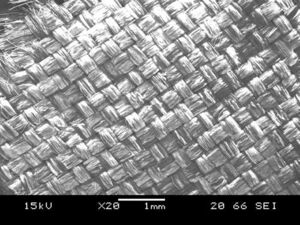

Where cloth material is readily available, fabric filtration is a simple method of improving water quality for developing nations.
In countries such as Kenya, where cloth material is a cheap and abundant resource, fabric filters provide a viable water sanitation solution. However, because the quality of the filter varies from fabric to fabric, this method of filtration is designed to be used alongside a water treatment agent which eradicates any harmful chemicals or microorganisms. This type of filter is primarily used to lower the turbidity (or "cloudiness") of the water to enhance the overall quality of the water. Most water treatments only eliminate the risk associated with the water contaminants – they do not rid the water of other unwanted particles in the water (such as clay, sand, leaves, dead bugs, etc.). This type of filtration is also often the only treatment used for water which is not meant for consumption.
Understanding the Market[edit | edit source]
Other water sanitation solutions which are already being implemented include:
- WaterGuard – a locally-produced sodium hypochlorite disinfectant widely used in Kenya
- Ceramic water filters
- Biosand filters
- Solar distillation
Design[edit | edit source]
There are a variety of options for the design of the filter, depending on whether the water is meant to be left to filter out on its own (by gravity), or if the filter is needed for more immediate water-usage. For the latter, the water will likely need to be filtered manually, and some important aspects to the mechanical design of the filter include:
- A method to force the water through the fabric (such as an easily squeezable / flexible container, or some sort of pumping mechanism)
- A means for which air is able to re-enter the container other than through the fabric (if a standard pump is not already used for this purpose), because the cloth often becomes caked with particles so that it is difficult for air to get back through
For the choice in fabric, it is necessary that it be tightly woven, and that it is made from a stiff material (any stretchiness will allow the gaps between the fibers to widen, and the water to seep through without being properly filtered). One material which is most commonly suitable for this purpose is silk, because unlike synthetic materials, silk fabrics do not exhibit a wide range of flexibility.
-
Imported clothing sold in Kenya
-
This silk fabric (from a pair of Women's pants) was especially effective in filtering the water which was sampled.
-
An SEM image of the silk fabric (this pattern is called a "plain weave")
-
These two samples were taken of the water (which contained clay particles of 20 microns in diameter or smaller) before and after it was filtered through the silk fabric.
Discussion & Conclusions[edit | edit source]
In Kenya, and other developing countries, clothing imported from other nations provide a cheap, easily accessible resource for water filtration. Although it is not "indigenous" to this region per se, it is an extremely useful resource which is able to provide the local citizens with a means of purifying water that they can easily institute themselves.



